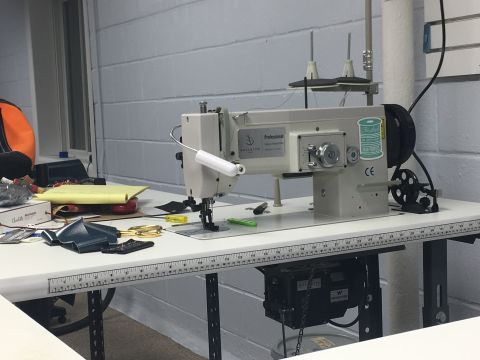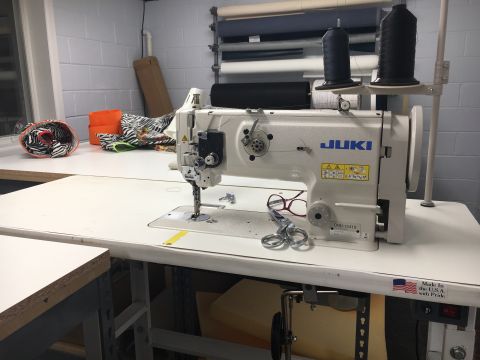Yes, it's a hobby but... how do you expect to do work without the right tools? A second sewing machine was/is absolutely necessary!!!
 Here's the advice I was given before buying the first sewing machine (a Sailrite Professional) by several people, including some of the folks at Sailrite. The Professional (a 4-point zigzag machine) is not an upholstery sewing machine. It was specifically designed and built to sew sails, canvas, and flat tough materials. While it will punch through upholstery fabrics with ease it has some limitations, to which I'll address shortly. But, I feel it's important to understand why this machine was purchased in the first place.
Here's the advice I was given before buying the first sewing machine (a Sailrite Professional) by several people, including some of the folks at Sailrite. The Professional (a 4-point zigzag machine) is not an upholstery sewing machine. It was specifically designed and built to sew sails, canvas, and flat tough materials. While it will punch through upholstery fabrics with ease it has some limitations, to which I'll address shortly. But, I feel it's important to understand why this machine was purchased in the first place.
Being a hobby, one that is self-financed, and with no promise that there will ever be a return on the investment, and with limited physical space at our disposal it made sense to buy the Professional because it would not only sew straight stitches, it could also sew zigzag stitches which is of utmost importance to us because we're both interested in repairing sails. In case you're not a sailor, let me assure you (and I'm sure Alan will wholeheartedly agree with me on this) sailing, like SCUBA diving, can get rather expensive! Therefore, rationalizing that only one machine could be afforded, both from a financial and physical space perspective, it made sense to buy the Professional. However, it seems like there are far more opportunities to work on re-upholstery projects than sail repair during the off-sailing season. And as you likely understand, there are only two seasons in Iowa, sailing on water, and sailing on ice. ;-)
Turning my attention to the Professional for a moment, it's truly a great machine. Easy to understand and use (at least at the superficial level), and the Sailrite staff have been a great resource - like the time I needed assistance lacing the thread through the machine correctly - but that's a different story. With a few attachments Alan and I have been able to make some pretty incredible bags and have developed a better sense of working with fabrics. However, some limitations of the Sailrite machine became apparent pretty early on. For example, the presser foot has a 7/16" lift. While this may sound impressive on its own, 7/16" barely lets you make small diameter piping. You see, a layer of material that may be 1/32" of an inch wrapped around a 5/16" foam core becomes 11/32" - that's getting tight. But the real issue is when sewing piping to other layers of fabric. That basically creates a 7/16" fabric/core thickness which brings us to the maximum presser foot lift - in other words, we've reached an impossible situation. A second, and perhaps even more problematic is the limited availability of presser feet for this machine - there are none. A couple of tentative workarounds exist but neither are satisfactory. One vendor on eBay sells piping feet for the Professional, and not to discredit or to speak negatively of him/her, the feet are designed to fit a different machine but "will work on the Professional" but "working on" and fitting properly as in "specifically designed for" are two completely different topics.
 With that said, Alan conducted a bit of research and found a few industrial sewing machines on Craig's List in Iowa. As it turns out, a Des Moines automotive shop had recently downsized and wanted to get rid of a couple of their machines. Both were well-maintained and recently serviced Juki DNU-1541S machines - a defacto standard in the industry. These machines have a presser foot lift of a little over 5/8" not to mention there is a plethora of feet specifically designed for and are readily available for this machine.
With that said, Alan conducted a bit of research and found a few industrial sewing machines on Craig's List in Iowa. As it turns out, a Des Moines automotive shop had recently downsized and wanted to get rid of a couple of their machines. Both were well-maintained and recently serviced Juki DNU-1541S machines - a defacto standard in the industry. These machines have a presser foot lift of a little over 5/8" not to mention there is a plethora of feet specifically designed for and are readily available for this machine.
After watching the advertisement for a few weeks I felt I'd make an offer. Much to my surprise when I looked up the contact information the seller had dropped his asking price to my price point. I called him immediately! Needless to say, a trip to Des Moines and few hours later I was in possession of a second sewing machine (technically third - I've been using a Janome for years) and some other goodies that made me feel even better about the deal!
Being of my father's genetic stock, I too am a bit of a tinkerer - a piddler if you will, so it didn't bother me in the least to investigate a couple of minor issues the machine had with sewing Sunbrella fabric. As it turned out, the thread take-up spring had a small issue, as well as the tension disc release mechanism. Both required a bit of investigation on my part - which feeds into my hobby interests and after a couple of days the Juki was humming along nicely sewing everything from Sunbrella to leather. I also got to learn more about sewing machines, needles, threads, and fabrics! Man, there's a ton of most excellent information out there if you're interested - especially if you're interested in sewing leather!
The bottom line is, I'm happy so that's that. With that said, was it a mistake to buy the Sailrite? I'd have to say no, perhaps a bit premature but like Alan, I want to learn more about sail repair and as I tell the students I work with, "You're never going to learn to swim until you get into the water."

